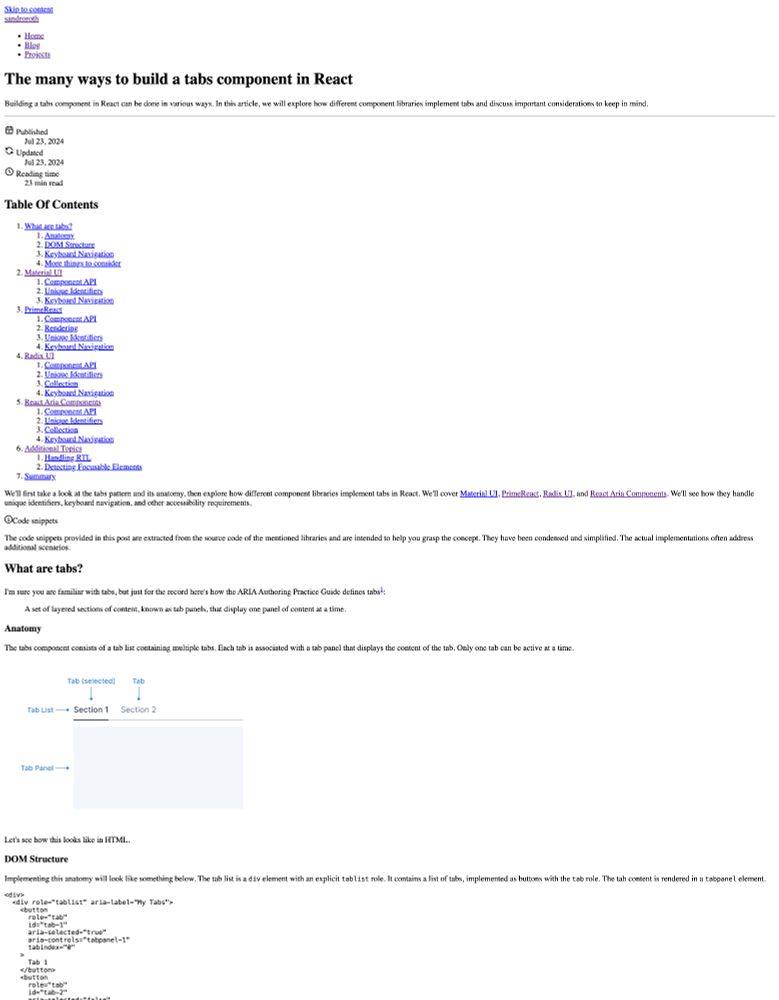Lucky you - we use a component library that often re-creates DOM elements when unstable values or callbacks are passed in 🤷♂️ 😢
28.07.2025 18:36 — 👍 1 🔁 0 💬 1 📌 0
Isn't that expected as Recoil is no longer maintained?
19.07.2025 13:58 — 👍 0 🔁 0 💬 1 📌 0
> Reproduction: I'm not lying
😂
14.07.2025 15:56 — 👍 2 🔁 0 💬 1 📌 0
Kill the Newsletter!
Convert email newsletters into Atom feeds
I don't have many email newsletters and just keep them in Readwise Reader. What's your workflow? Maybe you can use Kill the Newsletter.
07.06.2025 08:05 — 👍 0 🔁 0 💬 0 📌 0
Here we go 🥳
25.05.2025 18:11 — 👍 0 🔁 0 💬 1 📌 0

Finally found a way to archive interesting blog posts.
From RSS into Readwise Reader → Download via Reader API → Extract content as Markdown → Create Markdown file with Frontmatter → Move into Obsidian Vault → Create table with Obsidian Base 🚀
25.05.2025 18:10 — 👍 0 🔁 0 💬 0 📌 1
I'm struggling a lot with that 🤔 I use Readwise for RSS and email, but it’s not great for code-heavy articles or long-term bookmarking. Raindrop is good for bookmarks but lacks RSS/email. Obsidian + Clipper sounds nice for archiving, but syncing from Readwise is manual (and I'm lazy).
23.05.2025 19:56 — 👍 2 🔁 0 💬 1 📌 0
You can already display properties 🤨
22.05.2025 18:02 — 👍 1 🔁 0 💬 1 📌 0
Nice setup 👍 We use Vitest + happy-dom but we'll evaluate Vitest's browser mode when it's stable.
We have units tests for transition-heavy machines that are not fully covered by UI tests. UI tests give as much more confidence, they test everything together (just API request are mocked).
02.05.2025 04:27 — 👍 1 🔁 0 💬 0 📌 0
Then you don't test the UI components?
01.05.2025 20:23 — 👍 0 🔁 0 💬 1 📌 0
> [...] to validate my machines
Do you test your machines directly? I sometimes write test for the machine itself but mostly prefer to test the UI and treat the machine as an implementation detail.
And the UI doesn't even have to be implemented as a state machine for model-based testing.
01.05.2025 18:58 — 👍 0 🔁 0 💬 1 📌 0
I still need to learn more about how to model the machine for model-based testing, I think it's harder than modelling a machine for the app itself.
@davidkpiano.bsky.social Maybe something for your next talk 😉
01.05.2025 18:58 — 👍 1 🔁 0 💬 1 📌 0
I think Model-based testing is helpful if there are many UI states and interactions. Writing tests manually for all the possible transitions is a lot of work and it's easy to overlook some paths.
01.05.2025 18:58 — 👍 1 🔁 0 💬 1 📌 0
I just used Model-based testing for the first time. It's in a small side-projection and traditional tests would actually work fine for this use case. I'm still waiting for a good use case to come up at work.
01.05.2025 18:58 — 👍 1 🔁 0 💬 1 📌 0
I could be wrong but I think it happens if the promise resolves in less than 300ms (min duration for Suspense AFAIK) and the sibling component is updated after the promise resolved but before the 300ms are reached.
01.05.2025 18:33 — 👍 4 🔁 0 💬 1 📌 0
Interesting, I just have 3 snapshots (not 4) with the Body only being rendered once ("This is the first time the component rendered"), but render count is 2.
It's also reproducible with just `use(someStaticPromise)` without a query, so it's not doesn't seem to be related to uSES.
01.05.2025 18:33 — 👍 3 🔁 0 💬 1 📌 0
Model-based testing with XState helps you test your app more thoroughly without writing every test by hand. You define the model, add test code for states and events, and XState generates the rest. Here, I’m running over 60 tests from just one model. 🚀
#testing #xstate #statemachine
27.04.2025 17:05 — 👍 0 🔁 0 💬 1 📌 0

Not that bad 😇 but I'm unsure if it's a good idea, as plain HTML introduces other issues, such as overly long text lines that hinder readability 🤔
28.03.2025 19:56 — 👍 0 🔁 0 💬 1 📌 0
CSS Selectors Playground
My interactive playground for CSS selectors now uses @tanstack.com Start + Router. I also redesigned the homepage and added a few more selectors.
Do you miss a selector?
#css #react #tanstack
16.03.2025 08:45 — 👍 7 🔁 2 💬 1 📌 0
- Integration of other libs/state like a router.
- Simplify machines with many transitions (e.g. wizards, users can nav back to any not skipped step until submit state). Not sure how this could look like.
- Derived context/selectors
- Better type-safety
- Tell Copilot that v5 was released
19.12.2024 08:36 — 👍 3 🔁 0 💬 0 📌 0

A Visual Studio Code screenshot showing a TypeScript code snippet for defining German translations. The cursor is positioned at the value of the translation key "sidebar.navItemToggle.label," and an autocomplete popover suggests the default English translation "Toggle {{ title }}" as a possible value.
Using string union types for handling translations not only autocompletes the keys but also provides their default English translations. This helps you understand what to translate and identifies available dynamic values. TypeScript is incredibly powerful! 🚀
#TypeScript #i18n
01.12.2024 09:10 — 👍 2 🔁 0 💬 0 📌 0

```tsx
<!-- Approach 1: as prop -->
<Dialog.Close as={MyButton} variant="outlined">
<Icon />
<span>Close</span>
</Dialog.Close>
<!-- Approach 2: asChild prop (Radix UI) -->
<Dialog.Close asChild>
<MyButton variant="outlined">
<Icon />
<span>Close</span>
</MyButton>
</Dialog.Close>
<!-- Approach 3: render prop (Ariakit) -->
<Dialog.Close render={<MyButton variant="outlined" />}>
<Icon />
<span>Close</span>
</Dialog.Close>
```
React Component Composition with polymorphism is quite tricky. You loose type-safety and it's easy to break a11y.
The `as` prop is probably the worst (slow type checking + ambiguous props). `asChild` hurts readability and introduces additional nesting. Is @ariakit.org's `render` approach the best?
17.11.2024 19:12 — 👍 11 🔁 1 💬 0 📌 0
Bossing around computers in made-up languages.
Engineer, reader, amateur artist in many forms, sometimes writer, Pac-Man aficionado.
CTO at The Astro Technology Company https://astro.build/
Builder of https://yums.email/
Fullstack Web & XState freelancer
🎥 YouTube: https://youtube.com/@baptistedevessier
✉️ Newsletter: https://newsletter.baptiste.devessier.fr
🎙️ Podcast: https://parlons-dev.com/
design?ۗۗۗۗۗۗۗۗۗۗۗۗۗۗۗۗۗۗۗۗۗۗۗۗۗۗ engineer @ axiom.co
lead @proton.me (docs), writer at dio.la
- ex Automattic/WP core
- @ariakit.org & @biomejs.dev core, @solidjs.com ecosystem team, lexical.dev contributor
Building reshaped.so / designsystemchecklist.com 🚀
Staff Engineer at Shopify
🔵 Creator of motion.dev
📷 Photographer citizenofnowhe.re
👨🏻🍳 Software Cook, Teacher & Coach @ https://marmicode.io
✨ Google Developer Expert for #Angular
🌊 Nx Champion
✅ https://marmico.de/test.ng: Pragmatic Angular Testing Course
👨🏻🏫 https://marmico.de/workshops
📚 https://marmico.de/cookbook
The build tool for the web. It's pronounced /vit/ like skeet!
https://vite.dev
Freelance dev sending Frontend news to 6k people over at webweekly.email. Sharing lots of tips'n'tricks on the way.
Google Dev Expert, Microsoft MVP and Playwright Ambassador
An American in Spain, author of https://redux-form.com/ and https://final-form.org/.
Principal Product Engineer at @attio.com
https://erikras.com
Occasionally podcast at @happyhour.fm
frontend developer and consultant
HTML, CSS, accessibility
big fan of <button>s
creator of HTMHell
author of the Web Accessibility Cookbook
Next generation testing framework powered by @vite.dev ⚡️
https://vitest.dev
Content lead for Chrome Web Developer Relations. Opinions (and cats) my own.
Writing the React, fighting with the application state, designing the GraphQL APIs, cursing the TypeScript errors, learning Golang, migrating the databases, and admiring the amazing content at https://codepen.io.
https://rachsmith.com
staff design systems engineer @github.com + sometimes https://ui-devtools.com
🛜 https://sid.st
📍amsterdam
🦄 CSS Modules co-creator / 💿 Remix + React Router at Shopify / 🧁 Vanilla Extract / MelbJS organiser / dad x4
– Author of @ariakit.org
– Previously Automattic, WordPress
– JavaScript, CSS, Accessibility
– Autistic, dad, he/him






